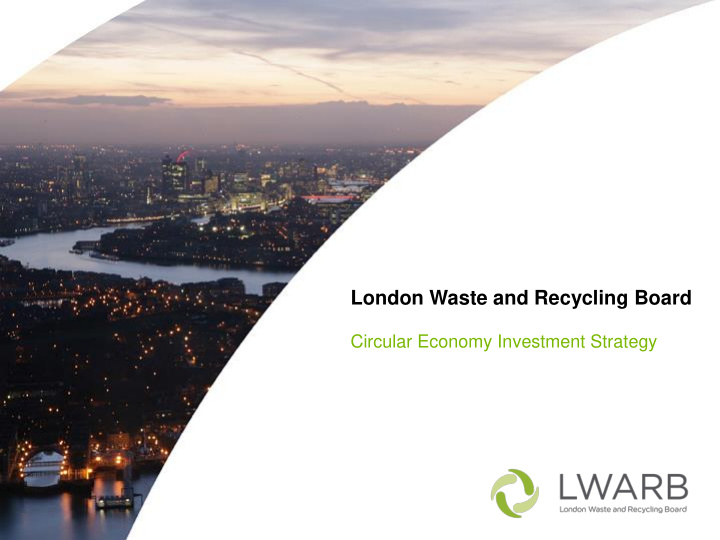



London Waste and Recycling Board Circular Economy Investment Strategy
Global Opportunity for CE Investing 2 | www.lwarb.gov.uk
European Investment in R&D as % of GDP 3 | www.lwarb.gov.uk
Why an Investment Programme? The London & UK Context 4 | www.lwarb.gov.uk
Why Public Sector Investment? The London & UK Context SMEs make up 99% of all London businesses and employ nearly 50% of the workforce; SME debt funding fell by 6% in 2016 – equity investment fell by 12%; Estimated to be an annual c £ 1.5bn funding gap for SMEs in London (debt and equity) vs demand; UK lags significantly behind other Developed Countries in innovation, measured in R&D spends as % of GDP – at 1.7% vs EU average of 2.1%, US at 3% and South Korea at 4.5%; Despite presence of world class universities, UK ranks 22 nd out of 30 countries measured in commercialising research; Risk that inward investment will fall post Brexit – already evidence that this is happening; BUT , London has several advantages to support SME circular economy innovation investment: World class academic institutions Large concentration of tech firms to facilitate CE Highly advanced and diverse Finance sector Host to a diverse range of SMEs with a culture of entrepreneurship Leading CE100 firms based in London able to influence their supply chain and provide support Data from 2011 to 2016 shows that if startups receive professional support through accelerator or VC then rate of failure drops from 80% to 16%! It is estimated that the CE focus areas alone could deliver benefits for London of at least £ 7bn per year by 2036 and 40,000 jobs. 5 | www.lwarb.gov.uk
Creating a Circular Economy Ecosystem 6 | www.lwarb.gov.uk
Creating a Circular Ecosystem in London Pre Startup Public innovation challenges in response to some of the main circular challenges in London Start-up Launched a small Accelerator programme for circular economy startups in conjunction with Sustainable Ventures – currently raising additional funds through Seedrs Working with partners to develop innovation centre to support best commercial ideas through funding and active support – likely launch early 2018. Longer-term, more value added support than typical accelerator/ incubator programme Growth capital Developing circular economy focused Venture Capital fund alongside GLA and EIB Targeting investments into up to 50 high growth early stage circular economy businesses, capable of impacting significantly upon they Mayor’s manifesto commitments LWARB has also invested in Europe’s first private equity growth capital fund dedicated to the circular economy (managed by Circularity Capital) Business Support Free business advisory support service for SMEs in London looking to transition to CE business models or scale up existing circular businesses – jointly funded by ERDF 1:1 support provided, objective to deliver economic value to London through new jobs and revenue streams. 7 | www.lwarb.gov.uk
Example Investments World’s 1 st dedicated circular economy Private Equity Fund, providing investments (£1 -5m) into high growth potential, established circular companies across W. Europe. Smart meter technology for professional kitchens to measure and analyse food waste, to help improve margins. Accelerator programme seeking to support 10 innovative circular economy startups in London. LWARB is anchor investor with the remaining funds raised through Seedrs. Startup that is seeking to eliminate plastic packaging – they have created an edible water pouch out of a seaweed membrane. 8 | www.lwarb.gov.uk
Challenges Limited number of early stage investable opportunities – need greater research investment, ideation competitions and pre-accelerator support schemes; However, these are unlikely to generate a return on investment due to the high failure rate; Most private investors have low risk appetite, therefore falls to public sector to fill gap; However , LWARB and other public sector investors are expected to run a commercial model too but often don’t have the same resources or skills as private firms; Brexit will have a big impact on early stage businesses – many founders or recruits are from Europe but evidence shows that numbers of overseas entrepreneurs going into accelerator programmes has fallen; Established SMEs much harder to reach and convince to adopt circular business models – typically have thin margins, little time or money to change; However , SMEs likely to face significant pressure to be more sustainable from companies at top of supply chain and challenged by new innovators below; Limited evidence base yet to prove that circular business models can drive strong investment returns; Circular Economy as a concept is not widely known by consumers or SMEs in the UK but we have seen some quality startups come through in the past 18 months; 9 | www.lwarb.gov.uk
How Can We Learn From Each Other? What level of public investment into SMEs is available in your region? What has worked well and what hasn’t? What are the investment needs of SMEs in your region? What role has the private sector played to date in sustainable/ circular investing? How can we engage the private sector further? What other non-financial means of support are available for SMEs? How can SMEs in our respective regions learn from each other’s experiences? What messaging and communication strategies have worked well in promoting the Circular Economy with businesses? 10 | www.lwarb.gov.uk
Recommend
More recommend